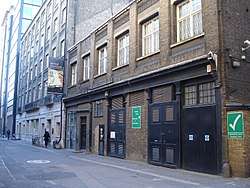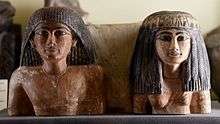Petrie Museum of Egyptian Archaeology
Coordinates: 51°31′25″N 0°7′59″W / 51.52361°N 0.13306°W

The Petrie Museum of Egyptian Archaeology in London is part of University College London Museums and Collections. The museum contains over 80,000 objects and ranks among some of the world's leading collections of Egyptian and Sudanese material.[1]
History

The museum was established as a teaching resource for the Department of Egyptian Archaeology and Philology at University College at the same time as the department was established in 1892.[2] The initial collection was donated by the writer Amelia Edwards.[3][4] The first Edwards Professor, William Matthew Flinders Petrie, conducted many important excavations, and in 1913 he sold his collections of Egyptian antiquities to University College, creating the Flinders Petrie Collection of Egyptian Antiquities, and transforming the museum into one of the leading collections outside Egypt. Petrie excavated dozens of major sites in the course of his career, including the Roman Period cemeteries at Hawara[5], famous for the beautiful mummy portraits in classical Roman style[6];[7] Amarna, the city of king Akhenaten;[8] and the first true pyramid, at Meydum, where he uncovered some of the earliest evidence for mummification.[9]
The collection and library were arranged in galleries within the university and a guidebook published in 1915. Initially, the collection's visitors were students and academics; it was not then open to the general public. Petrie retired from University College London (UCL) in 1933, though his successors continued to add to the collections, excavating in other parts of Egypt and the Sudan. During the Second World War (1939–1945) the collection was packed up and moved out of London for safekeeping. In the early 1950s it was moved into a former stable, where it remains adjacent to the science library of UCL.
Current description
The museum is at Malet Place, near Gower Street and the University College London science library. Admission is free, and as of January 2018 the museum is open each afternoon 1pm-5pm, Tuesday to Saturday, with researchers accommodated at other times as well.[10]
The museum has an education programme for adults and families,[11] and has an active Friends organisation allowing members to attend lectures, museum seminars, tours to Egypt and Egyptian collections, social events, and so on. As well, the Friends raise funds towards the conservation, publication and display of the Petrie Museum's outstanding collection.[12]
Organisation and collections
The museum is split into three galleries, with the main gallery (housed above the old stables) containing many of the museum's small artifacts, as well as tablets of writing and mummy portraits and cases. Another gallery contains mainly pottery. The third is along a stairwell down to an emergency exit. Some parts of the collection are not lit to protect light-sensitive items, and torches (flashlights) are supplied to see inside the cases.
The collection has been digitised and the catalogue can be browsed and consulted online.[13]
Notable holdings
The collection contains some significant 'firsts': one of the earliest pieces of linen from Egypt (about 5000 BC); two lions from the temple of Min at Koptos, from the first group of monumental sculpture (about 3000 BC, these are located in the main UCL building); a fragment from the first kinglist or calendar (about 2900 BC); the earliest example of metal from Egypt, the first worked iron beads; the earliest example of glazing; the earliest 'cylinder seal' in Egypt (about 3500 BC); the oldest wills on papyrus paper; the oldest gynaecological papyrus; the only veterinary papyrus from ancient Egypt; and the largest architectural drawing, showing a shrine (about 1300 BC).
Costume is another strength of the collection.[14] In addition to the 'oldest dress' there is a unique beadnet dress of a dancer from the Pyramid Age (about 2400 BC), two long sleeved robes of the same date, a suit of armour from the palace of Memphis, as well as socks and sandals from the Roman period. The collection contains works of art from Akhenaten’s city at Amarna: colourful tiles, carvings and frescoes, from many other important Egyptian and Nubian settlements and burial sites. The museum houses the world’s largest collection of Roman period mummy portraits (first to second centuries AD).[7]
The collection also includes material from the Coptic and Islamic periods.[15]
There is a substantial archive held in the museum, including excavation records, correspondence and photographs relating to excavations led by Flinders Petrie. There are additionally documents relating to the distribution of finds from fieldwork to museums worldwide between the 1887 and 1949. [16]
Reputation
The museum contains over 80,000 objects and ranks among some of the world's leading collections of Egyptian and Sudanese material.[17] It only ranks behind the collections of the Cairo Museum, The British Museum and the Ägyptisches Museum, Berlin in number and quality of items.
Published works
In 2015, the museum, in conjunction with UCL, published a multi-author compilation of articles, The Petrie Museum of Egyptian Archaeology: Characters and Collections, which is available in both print and via a free open access download.[18] It is edited by Alice Stevenson.
References
- ↑ "UCL Petrie Museum Online Catalogue". petriecat.museums.ucl.ac.uk. Retrieved 2018-06-21.
- ↑ "UCL: The Petrie Museum of Egyptian Archaeology - Museum Mile". museum-mile.org.uk. Retrieved 2018-06-21.
- ↑ Moon, Brenda E. (2006). More Usefully Employed: Amelia B. Edwards, Writer, Traveller and Campaigner for Ancient Egypt, London: Egypt Exploration Society.
- ↑ Willey, Russ (24 November 2014). "Rehumanising the past. Petrie Museum, behind Gower Street, Bloomsbury". London, ENG: Hidden London [Russ Willey]. Retrieved 24 November 2014.
- ↑ Alice Stevenson, UCL Press (2015-06-04). The Petrie Museum Of Egyptian Archaeology.
- ↑ "https://www.metmuseum.org/press/exhibitions/2000/ancient-faces-mummy-portraits-from-roman-egypt". www.metmuseum.org. Retrieved 2018-06-21. External link in
|title=(help) - 1 2 [Unknown author] (2007). "[Unknown chapter]". In Picton, Janet; Quirke,, Stephen & Roberts, Paul C. Living Images: Egyptian Funerary Portraits in the Petrie Museum. Walnut Creek, CA: Left Coast Press.
- ↑ "The Central City - Amarna The Place - Amarna Project". www.amarnaproject.com. Retrieved 2018-06-21.
- ↑ UCL. "UCL - London's Global University". UCL CULTURE. Retrieved 2018-06-21.
- ↑ Petrie Museum Staff. "Petrie Museum". ucl.ac.uk. Retrieved 6 January 2018.
- ↑ UCL. "Get Hands on with ancient Egypt". UCL CULTURE. Retrieved 2018-06-21.
- ↑ Petrie Museum Staff (28 February 2017). "Friends of the Petrie Museum Membership". Petrie.UCL.ac.uk. Retrieved 28 February 2017.
- ↑ Petrie Museum Staff (28 February 2017). "UCL Petrie Museum Online Catalogue". Petrie.UCL.ac.uk. Retrieved 28 February 2017.
- ↑ Hall, Rosalind M. (1986). Egyptian Textiles. Shire Publications.
- ↑ Petrie Museum Staff (2 March 2013). "Trails and Resources". Petrie.UCL.ac.uk. Archived from the original on 2 March 2013. Retrieved 28 February 2017.
- ↑ http://egyptartefacts.griffith.ox.ac.uk/
- ↑ https://www.ucl.ac.uk/culture/petrie-museum/about
- ↑ Stevenson, Alice, ed. (2015). The Petrie Museum of Egyptian Archaeology: Characters and Collections (PDF). London, ENG: UCL Press. Retrieved 28 February 2017.
Further reading
- Margaret S. Drower, Flinders Petrie: A Life in Archaeology, (2nd publication) University of Wisconsin Press, 1995. ISBN 0-299-14624-3.
- William Matthew Flinders Petrie, Seventy Years in Archaeology, H. Holt and Company 1932.
- Petrie, W. M. Flinders Sir, 1853-1942 Tell el-Amarna, London, Methuen & Co.
External links
| Wikimedia Commons has media related to Petrie Museum. |